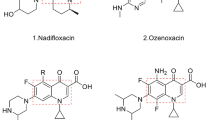Abstract
In this study, twenty-one arylaminoquinoxalinone derivatives were synthesized and their antibacterial activities against Staphylococci aureus, Pseudomonas aureus, Escherichia coli, Bacillus subtilis, Salmonella typhi, and Shigella pneumoniae were evaluated relative to known antibiotics; augmentin, ampicillin, and chloramphenicol. The insecticidal activities of the prepared compounds were also investigated against Tribolium castaneum using permethrin as a standard insecticide. The derivatives were synthesized using both conventional and microwave techniques. Their structures were confirmed using spectral techniques and elemental analysis.
Similar content being viewed by others
References
Ali, M. M., Ismail, M. M., El-Gaby, M. S., Zahran, M. A., and Ammar, Y. A., Synthesis and antimicrobial activities of some novel quinoxalinone derivatives. Molecules, 5, 864–873 (2000).
An, D. and Peng, Z., Synthesis of pyrimidine derivatives carrying nitrogen-containing benzoheterocycles. Hunan Daxue Xuebao, Ziran Kexueban, 30, 29–31 (2003).
Atta-ur-Rehman, M., Studies in natural product chemistry. Elsevier Science Publishers, Netherlands, pp. 383–384, (1991).
Atta-ur-Rehman, M., Choudhary, I., and Thomson, W. J., Manual of Bioassay techniques for natural product research. Harward Academic Press, Amsterdam, pp. 82–84, (1999).
Atta-ur-Rehman, M., Choudhary, I., and Thomson, W. J., Bioassay techniques for drug development. Harward Academic Publishers, France, pp. 67–68, (2001).
Cai, S. X., Huang, J. C., Espitia, S. A., Tran, M., Ilyin, V. I., Hawkinson, J. E., Woodward, R. M., Weber, E., and Keana, J. F., 5-(N-oxyaza)-7-substituted-1,4-dihydroquinoxaline-2,3-diones: novel, systemically active and broad spectrum antagonists for NMDA/glycine, AMPA, and kainate receptors. J. Med. Chem., 40, 3679–3686 (1997).
Csikós, É., Gönczi, C., Podányi, B., Tóth, G., and Hermecz, I., Regioselectivity in preparation of unsymmetrically substituted 3-aminoquinoxalin-2(1H)-ones. J. Chem. Soc. Perkin Trans. I, 1789–1794 (1999).
Haworth, H. D. and Robinson, S., Synthetic antimalarials. Part XXVII. Some derivatives of phthalazine, quinoxaline, and isoquinoline. J. Chem. Soc., 174, 777–782 (1948).
Jaso, A., Zarranz, B., Aldana, I., and Monge, A., Synthesis of new quinoxaline-2-carboxylate 1,4-dioxide derivatives as anti-mycobacterium tuberculosis agents. J. Med. Chem., 48, 2019–2025 (2005).
Khan, S. A., Synthesis, characterization and in vitro antibacterial activity of new steroidal 5-en-3-oxazolo and thiazoloquinoxaline. Eur. J. Med. Chem., 43, 2040–2044 (2008).
Kim, H. S. and Kim, J. H., Synthesis and tautomerism of novel quinoxalines. J. Korean Chem. Soc., 47, 241–249 (2003).
Kucybala, Z. and Paczkowski, J., 3-Benzoyl-7-diethylamino-5-methyl-1-phenyl-1H-quinoxalin-2-one: an effective dyeing photoinitiator for free radical polymerization. J. Photochem. Photobiol. A Chem., 128, 135–138 (1999).
Palanichelvam, K., Cole, A. B., Shababi, M., and Schoelz, J. E., Agroinfiltration of Cauliflower mosaic virus gene VI elicits hypersensitive response in Nicotiana species. Mol. Plant Microbe. Interact., 13, 1275–1279 (2000).
Perkin, W. H. and Riley, G. C., Derivatives of tetrahydrocarbazole Part 4. J. Chem. Soc., 123, 2399–2409 (1923).
Rangnekar, D. W. and Sonawane, N. D., Synthesis and application of 2-styryl-6(7)-bromothiazolo[4,5-b]quinoxaline based fluorescent dye chromophores: Part 2. Dyes Pigm., 45, 87–96 (2000).
Sakata, T., Tanaka, D., Takahashi, M., Sakaguchi, T., Oka, R., and Nishiyama, T., Antioxidant activity and oxidation products of 1,2,3,4-tetrahydroquinoxalines in peroxyl radical scavenging reactions, Part II. Technol. Rep. Kansai Univ., 47, 39–48 (2005).
Sarges, R., 4-Arylsulfonyl-3,4-dihydro-2(1H)-quinoxalinone-1-alkanoic acids, esters, and salts. U.S. Patent 4,940,708 (1990).
Toshima, K., Kimura, T., Takano, R., Ozawa, T., Ariga, A., Shima, Y., Umezawa, K., and Matsumura, S., Molecular design, chemical synthesis and biological evaluation of quinoxaline-carbohydrate hybrids as novel and selective photo-induced DNA cleaving and cytotoxic agents. Tetrahedron, 59, 7057–7066 (2003).
Zhang, L., Qiu, B., Li, X., Li, X., W., J., Zhang, Y., Liu, J., Li, J., and Shen, J., Preparation of 6-substituted quinoxaline JSP-1 inhibitors by microwave accelerated nucleophilic substitution. Molecules, 11, 988–999 (2006).
Zhao, Z., Wisnoski, D. D., Wolkenberg, S. E., Leister, W. H., Wang, Y., and Lindsley, C. W., General microwave-assisted protocols for the expedient synthesis of quinoxalines and heterocyclic pyrazines. Tetrahedron Lett., 45, 4873–4876 (2004).
Author information
Authors and Affiliations
Corresponding author
Rights and permissions
About this article
Cite this article
Nasir, W., Munawar, M.A., Ahmed, E. et al. Synthesis of novel quinoxalinone derivatives by conventional and microwave methods and assessing their biological activity. Arch. Pharm. Res. 34, 1605–1614 (2011). https://doi.org/10.1007/s12272-011-1004-4
Received:
Revised:
Accepted:
Published:
Issue Date:
DOI: https://doi.org/10.1007/s12272-011-1004-4




